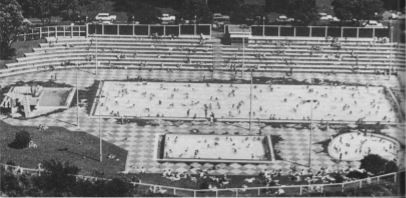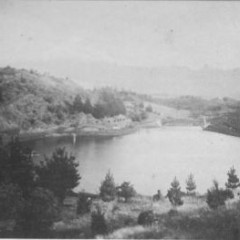13:5
In the early 1970s the brothers became world badminton figures, winning several British and European titles The overthrow of the Shah ofIran in 1979 had its repercussions in New Zealand, as it did in most of the western world. The growing world shortage of oil fuel which had for six years been the subject of official warnings, but little action by the authorities, became a reality when the Shah's successor, Ayatolla Khomeiny, became head of a regime whose policy resulted in drastic cuts in oil exports. The New Zealand Government introduced carless days, and reduced trading hours by service stations, and there was talk of petrol rationing. Within weeks New Plymouth cycle dealers reported a phenomenal demand for new cycles, and old machines were brought out of storage, refurbished and sold for five or six times their original purchase price. Topographically, New Plymouth has never been kind to cyclists. Unlike Christchurch, the 'home' of cycling in New Zealand, the undulating nature of the city's layout had prevented cycling from becoming a serious form of transport. But more than a century ago there were adventurous souls who invested in that modern marvel, the penny-farthing, whose 220cm front and tiny rear wheels were as unequal in size as the two coins from which it derived its nickname. George's Cycles placed one above its veranda in Brougham Street, and several of these 'front-wheel-drive' machines, despite their very real over-the- handlebars dangers, were sold. Then in the late 1880s came the chain-driven equal-sized wheel' safety cycle,' forerunner oftoday's ten-gear roadster. Clubs were formed and races organised. The first recorded event took place 'on Thursday, May 30, 1880, between W. H. Clarke and W. Perry.'IS The distance was a mile, starting from White's Store in Devon Street and finishing after several deviations at the Red House Hotel (now the State). Clarke won in four minutes. The match was for 'a small sum.' It was some years before cycling became an organised sport in the town. The Star Athletic Club held races in 1906 on a banked clay track in Fitzroy. In 1911 the Rover Cycling Club was formed and the first Round-the-Mountain race was run. This unique event was (and still is) the only race in the Southern Hemisphere which starts and finishes in the same place without covering any part of the course twice. Its prize, then, was a silver cup worth $100 plus $100 in cash, and was won by Jim Clarke, of Palmers ton North. Rovers went into recess in 1914 until 1919 when its name was changed to the New Plymouth League Cycle Club. In 1936 the name was changed again to the New Plymouth Cycling and Athletic League to cater for the many cash athletes who competed at country sports meetings. Club racing ceased during World War Two, but schoolboy events from New Plymouth to Waitara and return were conducted by Alex Gable and Roy Yardley. Petrol was scarce and none could be spared to carry stewards. Gable, who lived in New Plymouth, would start the races, and Yardley, of Waitara, would act as turn steward. The annual mountain race, and other club activities, were resumed after the war and in 1961, the 50th anniversary of the race, all but three of the previous winners attended the jubilee meeting. The actual 50th race was held in 1974 with many old riders attending from all parts of New Zealand. The cycling league has had several venues for its club meetings. There was a cinder track at Western Park, which was abandoned in the 1930s for the clay track at Rugby Park. During the war motorcyclists added shingle to the surface which made it difficult for the cyclists. As a result of a queen carnival in 1948 the league raised enough money to construct the present banked sealed track which has seen top cash cyclists compete, as well as weekly club meetings. Among many national champions from the league were Sid McKain, Clarry Parker, Manny Snowden, Jack Foote and George Wharehoka. Doug Bond, himself winner of the Round-the-Mountain Race in 1938, has been secretary of the league since the early 1940s. These were the professionals who preferred to call themselves cash cyclists. Amateurs have been catered for by the New Plymouth Amateur Athletic and Cycling Club, with headquarters at Pukekura Park. The club was formed in 1921, and has done perhaps more than any other sporting organisation which uses the ground, to develop amenities at the park. • In the early days men and boys were the only competitors, but in 1930 women began competing. They were required to wear 'a one-piece frock, pleated skirt open both sides, plain top with amber canoe collar, sleeves and a belt, amber band, black running shoes, no stockings. No girl to compete unless in proper uniform.' 16 The harrier and road cycling clubs, both of which conducted races under the jurisdiction of the club, formed separate committees and . launched organisations in their own right in 1934. The amateur mountain race, which is usually held a week after the professional event, was started in 1951. In 1980 the Rotary Club of New Plymouth West organised a 10km 'bike-hike' when more than 500 competitors of all ages took part, the proceeds going to the city's crippled children. This was planned as an annual event. Athletic meetings continued in Pukekura Park, attracting many top athletes and grasstrack cyclists and large crowds to watch them. The highlight of annual events was the Boxing Night trophy meetings which thousands of spectators attended. They saw Peter Snell, Murray Halberg, Bryan Rose, Norman Read, Kevin Gibbons and many other athletes who achieved world fame as Olympic and Commonwealth Games champions
In contrast to their fellows in the metropolitan areas, New Plymouth golfers are fortunate. Within a short radius of the city there are seven courses, all attractive in their own way, but all with less than optimum use and most occupying land with high productive potential. This has been the subject of much discussion, most players agreeing that while small membership and comparatively low subscriptions have their compensations, they are obstacles to development. Suggestions for amalgamation have received thought, but little else. The city's first course was established early in the 1880s on property owned by Stanley Shaw between Breakwater Road and the railway line to the port. It was a nine-hole course, and among its early presidents was Arthur Standish (the town's first mayor, and later the club's first life member). Other golfers at 'Ngamotu,' all prominent figures in the town included DrE. A. Walker, S. W. Shaw, J. G. George, W. C. Weston and Dr George Home. During the Boer War further property to the south was acquired, and one hole was called Spion Kop. In 1902 the club moved to Whitiora, at Westown, part of which was on the present site of Rugby Park, and four years later the first Taranaki championships were played there, attract- ing several prominent New Zealand players, including Aucklander J. C. Burns, who won the title. Since Whitiora was available only on a yearly tenancy, the club leased 90ha of Maori land (its present site) from the trustee, Newton King, which it acquired, after lengthy negotiations, in 1913. Years of development followed, and in 1933 Ngamotu was able to take its place among the country's leading courses both from a player's and spectator's point of view. Freehold possession was acquired in 1970. Ngamotu has been the venue for several New Zealand champion- ships-the first in 1936-at which many of the world's top players have competed. These include Bobby Locke, Peter Thompson, Bob Charles, Sloan Morpeth, Brian Silk and Tim Woon. Notable New Plymouth players and administrators have included Brian Twomey, a one-armed player who holed in one; the father and son 'team,' R. H. and P. J. Quilliam; Philip Grey, Leger Reeves, the Jeffrey Family-Joe, who was greenkeeper for 40 years, and his sons, Tom and Jim, both renowned players; D. V. Sutherland the city's golfing mayor; and P. L. Phillipps, a member of the New Zealand Golf Council. Women players have included Nora Curtis and Isobe1 Besley, both members of the New Zealand Ladies' Golf Union, and Glennis Taylor who, in addition to her New Zealand triumphs, captained the 1970 New Zealand team for the Espirito Santo tournament in Spain. When Ngamotu was transferred to its present site many members who felt the added distance involved, and an increase of the annual subscription, were beyond their means, decided to form a new club. In 1935 an area ofland at Westown bordering Waimea and Tukapa Streets was acquired. Most of it was part of Clarrie Clark's farm, which was leased, and the rest was bought from the hospital board. James Lobb was the first president, and at an early meeting he outlined the Westown Golf Club's policy: 'I hope that this will become a working man's club, and that ensuing committees will keep the subscriptions to approximately one week's pay of the average worker.'17 The subscription was fixed at $6, compared with $12 at Ngamotu. (In 1980 fees were $100 and $150 respectively). A 12-hole course was formed. As the club prospered this was extended to 18, but many players complained that this move made it too cramped. This, combined with the increasing membership and the fact that the leased land was to be sold for housing, resulted in Westown Golf Club in 1959 being transferred some lOkm out of town to an area on the corner of Baker and Mangorei Roads, its present site, since when it has been developed into a fine 18-hole course. The demand for a municipal course in the town resulted in the borough council of the 1920s laying out a nine-hole links at Peringa Park Reserve, Fitzroy. This proved popular with casual golfers, and soon the course was extended. In 1932 the Fitzroy Golf Club was formed and the course was officially opened by the Mayor, H. V. S. Griffiths. The council provided a caretaker who maintained the course. Golfing working bees gradually extended the playing area to a full 18-hole course and a pavilion was erected. In 1970 the golf club took over the lease from the council, the course was improved and a new pavilion was built. In 1980 there were more than 500 playing members.
In Laws against fighting in a public place, and creating a disturbance, have been on the statute books since the early days of settlement in New Zealand. But a fight has always been regarded by some, however mistakenly, to be the quickest way of settling an argument. In the rough and ready atmosphere of early New Plymouth, these were common, often drawing crowds. They were private affairs. Even in the 1880s, when men like Jem Mace ofTimaru, the last of the bare-knuckle brigade, toured the country and set himself up as 'a teacher of boxing,' and travelling circuses with their boxing booths challenged allcomers to beat their 'champions,' boxing was not recognised as a sport. Although the New Zealand Boxing Association was formed in 1902, on an amateur basis, and later embracing professionals, the Taranaki association was not established until 1920, when G. A. Clarke presided over 12 members. The association has had an on-again off-again existence, but it has produced several national titleholders. Most prominent was feather- weight Tommy Donovan (a Waitara fireman) who won the title in 1927,

